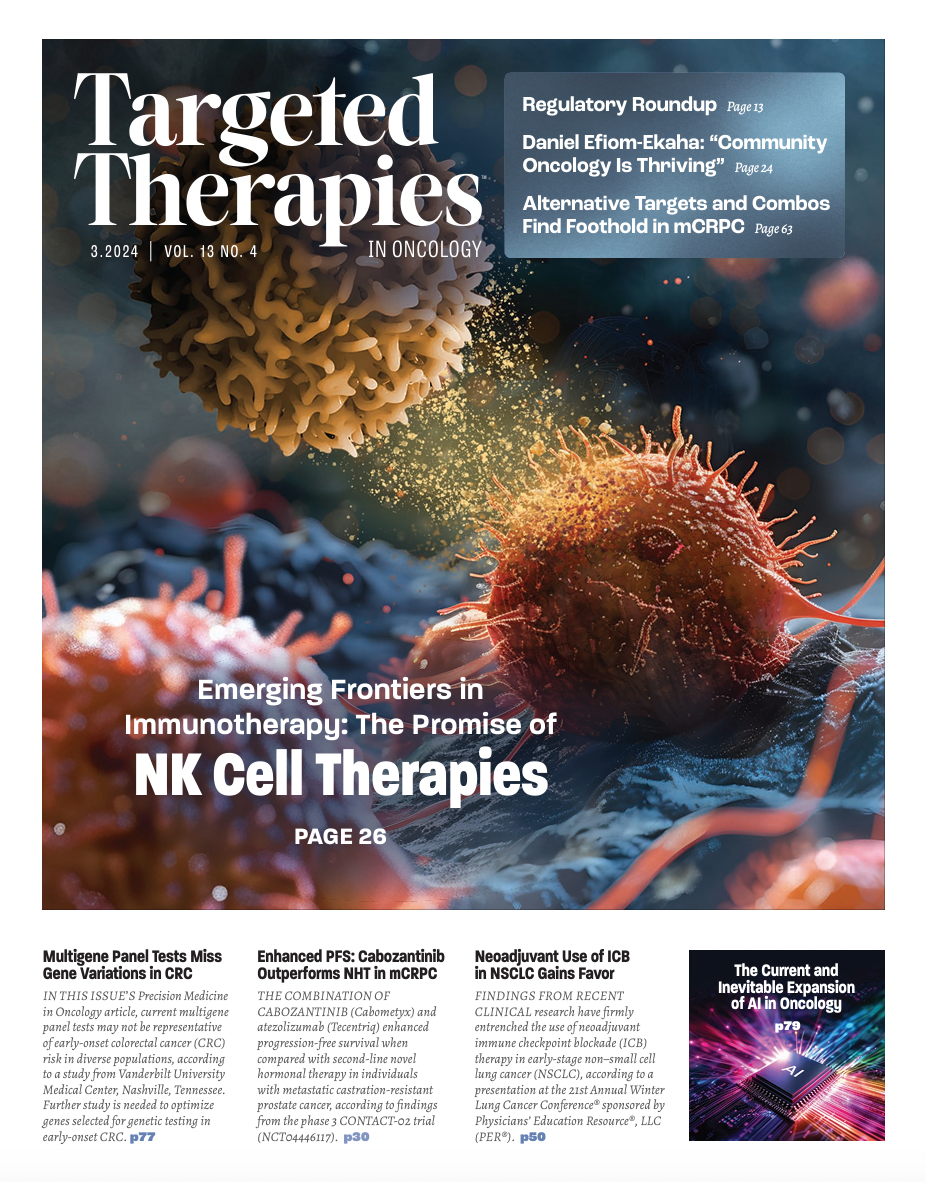Understanding ADC Mechanism of Action Enhances Personalized Medicine in NSCLC
There is currently 1 FDA-approved antibody-drug conjugate available for patients with non-small cell lung cancer, and several more potentially coming down the pike.

Although a fundamental understanding of the mechanism of action for the antibody-drug conjugate (ADC) class has evolved, deeper evaluation will lead to the opportunity to fully explore personalized medicine in non–small cell lung cancer (NSCLC). There is currently 1 FDA-approved ADC in this population and several more potentially coming down the pike. Further research is needed to improve understanding of the unique mechanism of action of these agents and properly identify patients who can benefit from this novel therapeutic class, according to Benjamin Levy, MD. An enhanced understanding of how ADCs work can help optimize their use in NSCLC and overall establish a more personalized approach to treatment.
“ADCs represent a novel therapeutic for patients with NSCLC, [but] we need more work [in this area],” Levy said in a presentation at the 21st Annual Winter Lung Cancer Conference, sponsored by Physicians’ Education Resource, LLC.1 “We are just at the ground floor and only have a nascent understanding of how these drugs truly work, who they’re going to work for, how they’re going to be sequenced, and what the mechanisms of resistance are. The future is bright though and we should] keep an eye on some of these new compounds that are coming out.”
Levy is the clinical director of medical oncology at Johns Hopkins Sidney Kimmel Cancer Center at Sibley Memorial Hospital and an associate professor of oncology at Johns Hopkins University School of Medicine in Baltimore, Maryland.
Understanding the Mechanism of Action of ADCs in NSCLC
ADCs have emerged as a novel therapeutic class in NSCLC, although their clinical utility in this setting is still nascent compared with that in other solid tumors. Comprising 3 key components—an antibody, a cleavable or noncleavable linker, and a payload moiety—ADCs target specific cell surface proteins on cancer cells, are internalized through endocytosis, and subsequently release the cytotoxic payload through either lysosomal degradation or physiologic conditions to trigger programmed cell death. Levy stated that although this basic mechanism of action has been well described, further study is needed to elucidate the complex avenues and broader effects by which ADCs function. “That explanation may be some of the story, but it is not all. We know that there are other ways that these drugs may work,” Levy said.
For example, Levy explained that ADCs exhibit a bystander effect allowing released payload moieties to affect adjacent cells regardless of whether they express the target protein. Additionally, ADCs can trigger an immunotherapeutic response by engaging effector immune cells through the Fc region of the monoclonal antibody, leading to antibody-dependent cell-mediated cytotoxicity. However, the intricacies of biomarker selection and response prediction in ADC therapy for patients with NSCLC require further investigation to optimize treatment strategies and improve patient outcomes.
Trastuzumab Deruxtecan
HER2 is currently considered the primary target for ADC development in lung cancer, particularly in HER2-altered tumors. In August 2022, the HER2-targeted ADC fam-trastuzumab deruxtecan-nxki (Enhertu; T-DXd) became the first ADC to be approved by the for the treatment of adult patients with unresectable or metastatic NSCLC whose tumors have activating HER2 mutations and who have received a prior systemic therapy.2 This regulatory decision was supported by findings from the phase 2 DESTINY-Lung02 trial (NCT04644237), in which patients were randomly assigned in a ratio to receive T-DXd at either 6.4 mg/kg (n = 152) or 5.4 mg/kg (n = 102) every 3 weeks.1,2
The study met its primary end point with a confirmed overall response rate (ORR) of 58% (95% CI, 43%-71%) and a median duration of response (DOR) of 8.7 months (95% CI, 7.1-not estimable) in the overall patient population.2 Findings from the primary analysis in the population of patients who received the 5.4 mg/kg dose showed that the median progression-free survival (PFS) was 9.9 months (95% CI, 7.4-NE) and the median overall survival was 19.5 months (95% CI, 13.6-NE).
Unexpected intracranial responses observed with T-DXd in patients with HER-mutated NSCLC further complicate oncologists understanding of ADC mechanisms of action and the traditional use of ADC to predict responses Levy explained. A pooled subset analysis of the DESTINY-Lung01 and DESTINY-Lung02 trials revealed consistent intracranial responses across different doses of T-DXd, regardless of baseline brain metastases status.4 In the DESTINY-Lung02 study, patients with baseline brain metastases treated with 5.4 mg/kg of T-DXd exhibited an intracranial ORR (IC-ORR) of . 50% (95% CI, 23.0-77.0) and an intracranial disease control rate (IC-DCR) of 92.9% (95% CI, 66.1%-99.8%). Similarly, patients treated with 6.4 mg/kg of T-DXd in DESTINY-Lung01 or DESTINY-Lung02 achieved a confirmed IC-ORR of 30.0% (95% CI, 14.7%-49.4%) and an IC-DCR of 73.3% (95% CI, 54.1%-87.7%).
“ACs have no business crossing the blood-brain barrier as they are large bulky molecules, but we now now from subset analyses that there are intercranial responses with T-DXd, specifically in HER2-mutated lung cancer... This forces us to think about how were going to treat patients who may have brain metastases and have HER2-mutated disease," Levy said.1
Further research is needed to elucidate the underlying mechanisms driving these intracranial responses and optimize treatment strategies for this patient population. The potential use of T-DXd as a first-line therapy is under evaluation in the phase 3 DESTINY-Lung04 trial (NCT05048797). The agent will be compared with standard platinum chemotherapy plus pemetrexed and pembrolizumab (Keytruda) in patients with unresectable, locally advanced or metastatic CC harboring HER2 exon or exon mutations.5
Ongoing Research
The exploration of biomarkers for ADC development in NSCLC is ongoing and targets of interest include HER3, TROP2, and CEACAM5, according to Levy. Prior research has shown that HER3 is expressed in of patients with NSCLC and may play a role in the development of EGFR-mutant lung cancer, he explained.
The emerging HER3-directed ADC patritumab deruxtecan (HER3-DXd) has demonstrated potential clinical benefit in this subset of patients. In December 2023, the accepted and granted priority review to the biologics license application for HER3-DXd for patients with locally advanced or metastatic EGFR-mutated NSCLC who previously received at least 2 systemic therapies. In the phase HERTHENA-Lung01 trial (NCT04619004) patients were highly pretreated and had characteristics reflecting those seen in real-world populations, Levy added. “There was a high rate of central nervous system metastases and liver metastases and the median number of prior lines of systemic therapy was," he said.1,7
Results from HERTHENA-Lung01 trial, which were presented during the IASLC World Conference on Lung Cancer and simultaneously published in the Journal of Clinical Oncology demonstrated an ORR of 29.8% (95% CI, 23.9%-36.2%) with HER3-DXd at a fixed dose of 5.6 mg/kg (n = 225). Moreover, the median DOR was 6.4 months (95% CI, 5.1-5.9).
HER3-DXd is being compared with platinum-based chemotherapy in the phase HERTHENA-Lung02 trial (NCT05338970) in patients with EGFR-mutated NSCLC who have progressed after third-generation EGFR tyrosine kinase inhibitor therapy.1,8
Telisotuzumab Vedotin
The first-in-class, c-Met protein–directed ADC telisotuzumab vedotin (Teliso-V) is under investigation in several settings within NSCLC, including in the second and third lines in EGFR wild-type, nonsquamous disease. In 2022, the FDA granted Teliso-V breakthrough therapy designation for patients with advanced or metastatic EGFR wild-type, nonsquamous NSCLC.
Results from an interim analysis of the phase 2 LUMINOSITY/M14-239 trial (NCT03539536), which enrolled patients with squamous or nonsquamous NSCLC with either EGFR wild-type or EGFR-mutant disease, supported this regulatory decision. Teliso-V produced respective ORRs of 53.8% and 25.0% in nonsquamous patients with high and intermediate c-Met expression. Teliso-V is also under evaluation in combination with osimertinib (Tagrisso) in the phase 1 M14-237 trial (NCT02099058) in patients with c-Met overexpressing EGFR wild-type nonsquamous NSCLC following progression on osimertinib. Early results demonstrate the activity of this compound in this population with an interim ORR of 58% (95% CI, 34%-80%).10
Up-and-Coming ADCs
Although the CEACAM5-targeted ADC tusamitamab ravtansine (SAR408701) generated responses in combination with pembrolizumab with or without chemotherapy in patients with nonsquamous NSCLC in the phase CARMEN-LC05 trial (NCT04524689), the global development of this agent was officially discontinued by Sanofi after the phase CARMEN-LC03 trial (NCT04154956) did not meet one of its dual primary end points of improved PFS with the agent in the second line.1,11 However, Levy said the broader development of CEA-CAM5-directed ADCs is slated to continue with additional anticipated trials.
Furthermore, the B7-H3–directed ADC ifinatamab deruxtecan (DS-7300; I-DXd) is under investigation in patients with advanced/unresectable or metastatic squamous NSCLC as part of the phase 1/2 DS7300-A-J101 trial (NCT04145622) of advanced solid tumors.1,12
“There are many ways we can leverage [ADC] technology," Levy said. “It all comes down to synthetic biochemistry. Keep your eye on some of these new compounds that are coming out."
REFERENCES:
1. Levy B. Are ADCs here to stay in lung cancer? Presented at: 21st Annual Winter Lung Cancer Conference; February 2-4, 2023; Hollywood, FL.
2. FDA grants accelerated approval to fam-trastuzumab deruxtecan-nxki for HER2-mutant non-small cell lung cancer. FDA. August 11, 2022. Updated August 16, 2022. Accessed February 6, 2024. https://tinyurl.com/yva38nrx
3. Goto K, Goto Y, Kubo T, et al. Trastuzumab deruxtecan in patients with HER2-mutant metastatic non-small-cell lung cancer: primary results from the randomized, phase II DESTINY-Lung02 trial. J Clin Oncol. 2023;41(31):4852-4863. doi:10.1200/JCO.23.01361
4. Li BT, Planchard D, Goto K, et al. Trastuzumab deruxtecan (T-DXd) in patients (pts) with HER2 (ERBB2)-mutant (HER2m) metastatic non–small cell lung cancer (NSCLC) with and without brain metastases (BMs): pooled analyses from DESTINY-Lung01 and DESTINY-Lung02. Ann Oncol.
2023;34(suppl 2):S762-S763. doi:10.1016/j.annonc.2023.09.2354
5. Li BT, Ahn MJ, Goto K, et al. Open-label, randomized, multicenter, phase 3 study evaluating trastuzumab deruxtecan (T-DXd) as first-line treatment in patients with unresectable, locally advanced, or metastatic non–small cell lung cancer (NSCLC) harboring HER2 exon 19 or 20 mutations (DESTINY-Lung04). J Clin Oncol. 2022;40(suppl 16):TPS9137.
doi:10.1200/JCO.2022.40.16_suppl.TPS9137
6. Patritumab deruxtecan granted priority review in the U.S. for certain patients with previously treated locally advanced or metastatic EGFR-mutated non-small cell lung cancer. News release. Daiichi Sankyo and Merck. December 22, 2023. Accessed February 6, 2024.
https://www.businesswire.com/news/home/20231221780782/en
7. Yu HA, Goto Y, Hayashi H, et al. HERTHENA-Lung01, a phase II trial of patritumab deruxtecan (HER3-DXd) in epidermal growth factor receptor-mutated non-small-cell lung cancer after epidermal growth factor receptor tyrosine kinase inhibitor therapy and platinum-based chemotherapy. J Clin Oncol. 2023;41(35):5363-5375. doi:10.1200/JCO.23.01476
8. HERTHENA-Lung02: a study of patritumab deruxtecan versus platinum-based chemotherapy in metastatic or locally advanced EGFRm NSCLC after failure of EGFR TKI therapy. ClinicalTrials.gov. Updated January 11, 2024. Accessed February 7, 2024. https://clinicaltrials.gov/study/NCT05338970
9. AbbVie announces U.S. FDA granted breakthrough therapy designation (BTD) to telisotuzumab vedotin (Teliso-V) for previously treated non-small cell lung cancer. News release. AbbVie. January 4, 2022. Accessed February 6, 2024. https://tinyurl.com/3dety28p
10. Goldman JW, Horinouchi H, Cho BC, et al. Phase 1/1b study of telisotuzumab vedotin (Teliso-V) + osimertinib (Osi), after failure on prior Osi, in patients with advanced, c-Met overexpressing, EGFR-mutated non-small cell lung cancer (NSCLC). J Clin Oncol. 2022;40(suppl 16):9013.
doi:10.1200/JCO.2022.40.16_suppl.9013
11. Sanofi announces end of program evaluating tusamitamab ravtansine after a 2L NSCLC phase 3 trial did not meet a primary endpoint. News Release. Sanofi. December 21, 2023. Accessed February 6, 2024. https://tinyurl.com/42encw2e
12. Patel MR, Doi T, Koyama T, et al. Ifinatamab deruxtecan (I-DXd; DS-7300) in patients with advanced solid tumors: updated clinical and biomarker results from a phase I/II study. Ann Oncol. 2023;34(suppl 2):S481-S482. doi:10.1016/j.annonc.2023.09.1876
13. Zhang, L, Ma Y, Zhao Y, et al. BL-B01D1, a first-in-class EGFRxHER3 bispecific antibody-drug conjugate (ADC), in patients with locally advanced or metastatic solid tumor: results from a first-in-human phase 1 study. J Clin Oncol. 2023;41(suppl 16):3001. doi:10.1200/JCO.2023.41.16_suppl.3001
